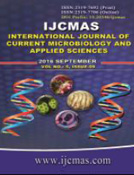


 National Academy of Agricultural Sciences (NAAS)
National Academy of Agricultural Sciences (NAAS)

|
PRINT ISSN : 2319-7692
Online ISSN : 2319-7706 Issues : 12 per year Publisher : Excellent Publishers Email : editorijcmas@gmail.com / submit@ijcmas.com Editor-in-chief: Dr.M.Prakash Index Copernicus ICV 2018: 95.39 NAAS RATING 2020: 5.38 |
Orthopaedic infections are associated with a high morbidity, often requires an aggressive antibiotic therapy. Bone infections remmains a serious therapeutic challenge and increasing resistance has complicated the management of infections. Delayed or ineffective treatment causes significant morbidity in terms of pain, loss of function and the need for further surgery and antibiotics. To study the aerobic bacteriological spectrum and antibiotic susceptibility pattern of isolates of orthopaedic wound infections. We performed a retrospective review of clinical and microbiological data sets using the access database of patients admitted in orthopedic ward for one year from august 2015 to july 2016. Out of 196 samples, 144(73.46%) yielded pure growth, 42(21.42%) mixed growth, 10(5.1%) showed no growth. Out of 230 bacterial strains isolated 112(48.69%) were Staphylococci and 118(51.3%) were Gram negative bacilli. Among the Staphylococcus spp, MRSA (50%), MSSA (33.9%), MSCONS (9%) and MRCONS (7.1%). Susceptibility pattern of MRSA isolates were 68% to cotrimaxozole, 43% to clindamycin,29% to erythromycin, 18% to gentamycin and all MRSA strains were sensitive to Vancomycin and Linezolid. Among Gram negative bacilli, Pseudomonas (25.4%), Escherichia coli(22%), Enterobacter (22%), Klebsiella (15.3%), Citrobacter (8.4%), Acinetobacter (3.3%) and Proteus (3.3%). Pseudomonas strains showed100% sensitivity to imipenem, 87% to piperacillin-tazobactum,73% to amikacin,66% to cefotaxime,47% to ciprofloxacin,27% to gentamycin. Knowing the prevalence and the antibiotic susceptibility pattern of the isolates, helps us to guide the clinician to select the most appropriate antibiotics thereby preventing indiscriminate use of antibiotics.
 |
 |
 |
 |
 |